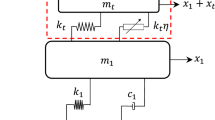Abstract
This paper’s objective is to obtain exact analytical parameters for Tuned Mass Dampers (TMDs) that derive their efficiency for controlling the seismic response by inducing two modes with equal damping ratios, when affixed to single-degree-of-freedom mechanical systems. The parameters that are derived are intrinsic to the systems and are independent of the ground motion. It is seen that for TMDs tuned with this criterion, as damping is increased a critical condition of multiplicity of eigenvalues is reached. The damping provided by the TMDs calibrated in this manner is effective only in the sub-critical range. As the critical and supercritical conditions are reached, the TMDs lose their efficiency, and are not adequate to reduce the response to seismic excitation. Nevertheless, in this paper the exact analytical parameters are provided for all conditions. It is shown that at the critical condition the derivation of parameters results in a commonly referenced work by others, who also proposed using TMDs for the purpose of seismic response abatement. Finally, some calculations in the frequency and time domains are presented to illustrate the utilization of the parameters that are derived, and to illustrate the effect of the TMD mass on the seismic response.













Similar content being viewed by others
References
Anajafi H, Medina R (2017) Partial mass isolation system for seismic vibration control of buildings. Structural Control Health Monitoring. https://doi.org/10.1002/stc.2088|
Anajafi H, Medina R (2018) Comparison of the seismic performance of a partial mass isolation technique with conventional TMD and base-isolation systems under broad-band and narrow-band excitations. Eng Struct 158:110–123
De Angelis M, Perno S, Reggio A (2012) Dynamic response and optimal design of structures with large mass ratio TMD. Earthquake Eng Struct Dynam 41:41–60
Chey MH, Chase JG, Mander JB, Carr AJ (2010b) Semi active tuned mass damper building systems: application. Earthquake Eng Struct Dynam 39:69–89
Chey MH, Chase JG, Mander JB, Carr AJ (2010a) Semi active tuned mass damper building systems: design. Earthquake Eng Struct Dynam 39:119–139
Chey MH, Chase JG, Mander JB, Carr AJ (2015a) 2015, Aseismic smart building isolation systems under multi-level earthquake excitations: Part I, conceptual design and nonlinear analysis. Front Struct Civ Eng 9:286–296
Chey MH, Chase JG, Mander JB, Carr AJ (2015b) Aseismic smart building isolation systems under multi-level earthquake excitations: Part II, energy-dissipation and damage reduction. Front Struct Civ Eng 9:297–306
Gasparini D.A., Vanmarcke E.H., 1976. Simulated earthquake motions compatible with prescribed response spectra. Department of Civil Engineering, Massachusetts Institute of Technology Publication o. R76-4
Hartog JPD (1985) 1956, Mechanical Vibrations, 4th edn. McGraw-Hill, New York (Reprinted by Dover, New York)
Hoang N, Fujino Y, Warnitchai P (2007) Optimal tuned mass damper for seismic applications and practical design formulas. Eng Struct 30:707–715
Hurty W.C., Rubinstein M.F., 1964. Dynamics of Structures. Prentice Hall.
Miranda JC (2005) On tuned mass dampers for reducing the seismic response of structures. Earthquake Eng Struct Dynam 34:847–865
Miranda JC (2013) A method for tuning tuned mass dampers for seismic application. Earthquake Eng Struct Dynam 42:1103–1110
Miranda JC (2015) Discussion of system intrinsic parameters of tuned mass dampers used for seismic response reduction. Struct Control Health Monitoring 23:49–368
Moutinho C (2012) An alternative methodology for designing tuned mass dampers to reduce seismic vibrations in building structures. Earthquake Eng Struct Dynam 41:2059–2073
Reggio A, De Angelis M (2015) Optimal energy-based seismic design of non-conventional Tuned Mass Damper (TMD) implemented via inter-story isolation. Earthquake Eng Struct Dynam 44:1623–1642
Sadek F, Mohraz B, Taylor A, Chung R (1997) A method of estimating the parameters of tuned mass dampers for seismic applications. Earthquake Eng Struct Dynam 26:617–635
Villaverde R (1985) Reduction in seismic response with heavily-damped vibration absorbers. Earthquake Eng Struct Dynam 13:33–42
Warburton GB (1982) Optimum absorber parameters for various combinations of response and excitation parameters. Earthquake Eng Struct Dynam 10:381–401
Acknowledgements
The findings, procedures, and opinions expressed in this paper are the sole responsibility of the author, and do not necessarily represent the practice of his employer, JACOBS.
Author information
Authors and Affiliations
Corresponding author
Additional information
Publisher's Note
Springer Nature remains neutral with regard to jurisdictional claims in published maps and institutional affiliations.
Rights and permissions
About this article
Cite this article
Miranda, J.C. Analytical parameters for equal mode damping ratio inducing TMDs for seismic response reduction. Bull Earthquake Eng 19, 263–285 (2021). https://doi.org/10.1007/s10518-020-00996-9
Received:
Accepted:
Published:
Issue Date:
DOI: https://doi.org/10.1007/s10518-020-00996-9




